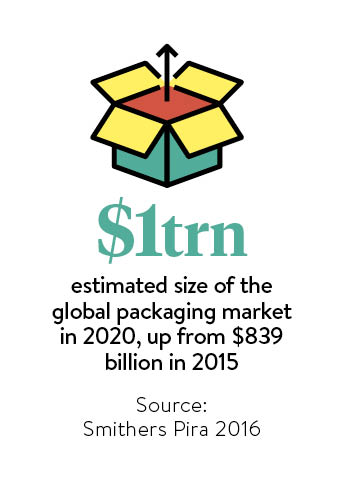We may take packaging for granted – indeed, failing to notice it can be a sign of its success. But in many cases, whether it is a child’s toy or a toothbrush that you just can’t get into, or an iconic symbol of a brand such as the original Coke bottle or the box the latest iPhone comes in, packaging can evoke surprisingly strong feelings, for good or ill.
Packaging has long since evolved from being just a way to keep products safe and secure in transit from producer to end-user. It is the consumer’s first point of contact with a product and so it now plays a vital role in building brand differentiation, awareness and loyalty.
Products can have huge amounts of resources invested in them, but then live or die as a result of their packaging. It can say more about a brand than the product inside – on issues ranging from the environment to the way the company sources ingredients – and some packaging has even become an unlikely star of social media thanks to the phenomenon of “unboxing” videos.
Packaging encompasses every sector of the economy – everything needs packaging, from herbs and spices to nuclear reactors
A recent survey revealed that the Coke bottle was the most recognisable piece of packaging in the UK, followed by the Toblerone box, the Marmite jar and the Pringles tube. “Innovative design alone cannot grant packaging iconic status – it needs to be ingrained to some extent in a culture’s subconscious,” according to Michael Grass of AD Communications. But, he adds: “Once that happens, it becomes nigh impossible to dissociate it from our collective memories.”
Making packaging sustainable
 By definition, packaging encompasses every sector of the economy – everything needs packaging, from herbs and spices to nuclear reactors. As a result, it is a huge market, set to reach almost $1 trillion by 2020, up from $839 billion in 2015. There are five main segments – paper and board, rigid plastic, glass, flexible plastic, and cans.
By definition, packaging encompasses every sector of the economy – everything needs packaging, from herbs and spices to nuclear reactors. As a result, it is a huge market, set to reach almost $1 trillion by 2020, up from $839 billion in 2015. There are five main segments – paper and board, rigid plastic, glass, flexible plastic, and cans.
All these materials are among the biggest sources of waste and recycled material, and sustainability is one of the key challenges for packaging companies. The sector is at the forefront of the fight to reduce waste, to lightweight products and to introduce a circular economy.
For some products, this is easy – everyone knows they can recycle cans, cardboard and bottles. However, when it comes to plastic packaging it can be a bewildering experience, not just trying to work out what type of plastic the packaging is, but also whether your local authority accepts it for processing. According to the Ellen MacArthur Foundation, just 14 per cent of plastic packaging is recycled and at least eight million tonnes a year leaks into the ocean.
The newly heightened awareness of the problem of ocean plastic and the speed of recent developments in the fight against climate change, such as the signing of the Paris Agreement in the past few weeks, mean it is inevitable the industry will face growing pressure to make packaging more recyclable and degradable both by simplifying the materials involved and through innovations in design. Plastic, in particular, is likely to be in the spotlight, not just because of its impact on pollution because it is made from oil, a fossil fuel that contributes to climate change.
Tech innovations
But at the same time, technological advances in digitisation, sensors and the internet of things are pushing in the opposite direction to make packaging more complex so products can be better tracked, secured and monitored.
“I think we’re at a tipping point: the intersection of e-commerce and sustainability,” said Marianne Rosner Klimchuk, associate chairwoman of the Fashion Institute of Technology, at the recent DuPont Awards for Packaging Innovation. “This moment in time is that pivotal point in which sustainability and e-commerce are coming together [with] people looking to reduce use of materials and thinking about innovation in terms of e-commerce.”
Although the technology is too expensive to be widely adopted at the moment, many millennials expect 3D printing to transform the world of packaging in years to come. In the same way that many products will become increasingly bespoke, so will the packaging. Coca-Cola and Nutella have led the way in packaging with people’s names on, but in future individual designs may be possible as well and packaging may play an even more important role in marketing products as a result of augmented reality.
Ultimately, packaging will have to respond to the same challenges that retail as a whole has to face. In addition to megatrends such as the ageing population, changing household sizes and increasing urbanisation, packaging will increasingly have to tell a story to consumers who, thanks to the spread of social media, are evermore inquisitive and proprietorial about the products they buy. The packaging of the future will carry more information than ever before.
This information will be directed at consumers to help them find out more about the provenance and ingredients of their products, and to interact with brands more. But information embedded in sensors and internet of things technology will also flow in other directions to reveal more about consumers to retailers and suppliers, via domestic appliances in connected homes.
Making packaging sustainable

